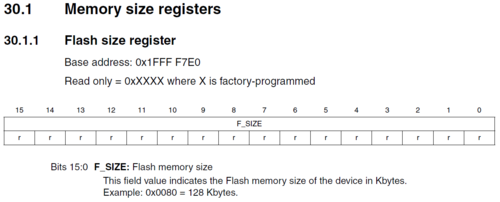Difference between revisions of "Const and volatile type qualifiers"
m (clean up) |
m (→Method 2: Reading the Flash size register) |
||
| Line 39: | Line 39: | ||
===Method 2: Reading the Flash size register=== | ===Method 2: Reading the Flash size register=== | ||
<source lang=c> | <source lang=c> | ||
| − | #define F_SIZE ((volatile uint16_t *) 0x1ffff7e0) // Flash Size | + | #define F_SIZE ((volatile uint16_t * const) 0x1ffff7e0) // Flash Size |
printf("Flashsize: %i KB\n\r", (int) *F_SIZE ); | printf("Flashsize: %i KB\n\r", (int) *F_SIZE ); | ||
</source> | </source> | ||
On the [[STM32F107VC]] the output to stdout would be '''Flashsize: 256 KB''' | On the [[STM32F107VC]] the output to stdout would be '''Flashsize: 256 KB''' | ||
| + | ===Method 3: Reading the Flash size register=== | ||
| + | |||
| + | Putting the pointer in the macro | ||
| + | <source lang=c> | ||
| + | #define F_SIZE (*(int volatile * const) 0x1ffff7e0) // Flash Size | ||
| + | |||
| + | printf("Flashsize: %i KB\n\r", (int) F_SIZE ); | ||
| + | </source> | ||
| + | On the [[STM32F107VC]] the output to stdout would be '''Flashsize: 256 KB''' | ||
| + | |||
|- | |- | ||
|} | |} | ||
Revision as of 15:41, 25 November 2015
const
const means that something is not modifiable, so a data object that is declared with const as a part of its type specification must not be assigned to in any way during the run of a program.
volatile
The use of volatile ensures that the compiler always carries out the memory accesses, rather than optimizing them out (for example if the access is in a loop).
Memorymapped access to a register
Example 1
In the example below the register 32 bit register located in memory at address 0x40000 can be accessed through the uartreg pointer.
In the example below uartreg is a pointer pointing to a unsigned int 0x40000. The pointer value in memory 0x40000 is a constant not what it points to in memory. Fx. a peripheral register.
unsigned int volatile * const uartreg = (unsigned int *) 0x40000;
*uartreg = 0x80000000; // Assign 80000000 to the 32 bit register located at memeory address 0x40000
...some code...
*uartreg |= 0x1 // *uartreg's contents is OR'et to 0x1. New contents = 0x80000001
Example 2
| From the Cortex M STM32F107VCs Reference manual - See picture below - that the size of the embedded Flash can be seen in KB from the Flash size register at memory location 0x1FFFF7E0. |
Method 1: Reading the Flash size register uint16_t volatile * const flashsize = (uint16_t *) 0x1ffff7e0;
printf("Flashsize: %i KB\n\r", (int) *flashsize );
On the STM32F107VC the output to stdout would be Flashsize: 256 KB |
Method 2: Reading the Flash size register#define F_SIZE ((volatile uint16_t * const) 0x1ffff7e0) // Flash Size
printf("Flashsize: %i KB\n\r", (int) *F_SIZE );
On the STM32F107VC the output to stdout would be Flashsize: 256 KB Method 3: Reading the Flash size registerPutting the pointer in the macro #define F_SIZE (*(int volatile * const) 0x1ffff7e0) // Flash Size
printf("Flashsize: %i KB\n\r", (int) F_SIZE );
On the STM32F107VC the output to stdout would be Flashsize: 256 KB |
